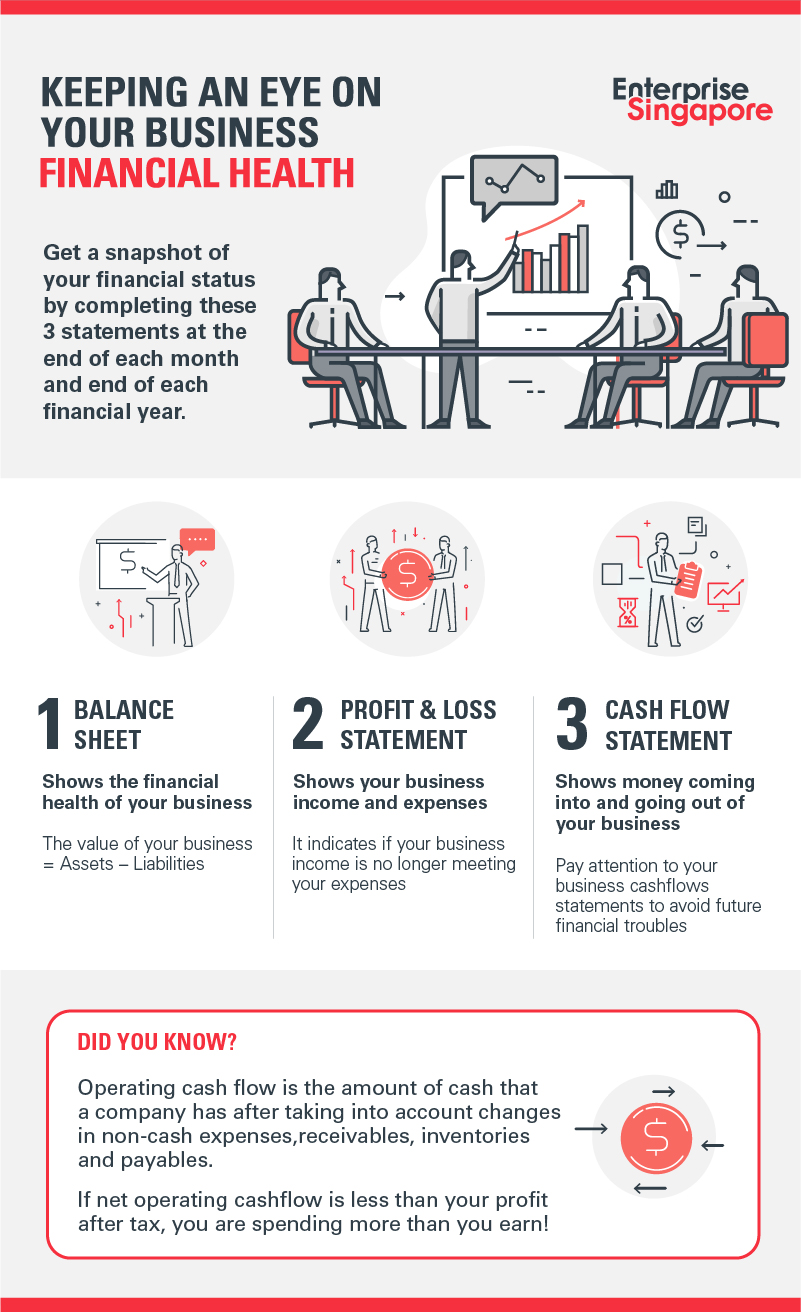Financing is vital to any business. If you own a small and medium-sized enterprise (SME), read on for tips to handle your finances, how to manage your working capital, and what to do after you have secured that bank loan.
5 essential financial management practices
Monitor and measure financial performance
Needless to say, you should keep a close watch on your cash flows, expenses and revenues. Don't forget to reconcile your bank statements regularly and monitor your receivables and payables. Compare your financial performance with the previous periods to evaluate the financial position of your company. When you keep tab on these indicators, you can make better projections for future revenue, expense and cash flow, as well as better business decisions.
Digitise – Use accounting software for accuracy
Find every opportunity to digitise your business especially for functions such as accounting, payroll and transactions. Using digital solutions is more efficient, transparent and accurate than book-keeping and prevents costly mistakes. Even spreadsheets like Microsoft Excel may not adequately support all your business processes. Not sure which digital solutions to use? Check out IMDA's Start Digital Pack under the SME Go Digital programme.
Separate your business and personal accounts
It makes good financial practice to separate your personal account from your business account. You will have clear financial statements and not distort the true financial performance of your company. A clean set of business accounts also means smoother financial audit and accurate tax calculations.
Bosses, level up your financial competency
Even if you have a reliable accountant or financial controller, as the CEO or business owner, the overall financial responsibilities for your business still rest on your shoulders. It pays to learn different aspects of finance to understand your balance sheet, income statement, cashflow statement, taxes etc.:


- Balance sheet shows your company's total assets, liabilities and capital at a particular point in time.
- Profit & loss or income statement shows the revenues generated and expenses incurred during a particular period.
- Cash flow statement shows details of the flow of cash (inward and outward) as a result of your company's operating, investment and financing activities.
These statements give a good idea of your company's financial position, enabling you to make sound business decisions.
Call in the Business Advisors
There may be times when you need help with financial matters or simply want a pair of fresh eyes for advice. Make an appointment with the friendly business advisors at the SME Centres or Trade Associations. They are on hand to dispense basic financial advice and assistance, which can come in handy in the current challenging business climate.
Managing your working capital
Cash - the lifeline of a business
Managing a sustainable business in a volatile environment requires adequate cash flow and funding at every stage of your business development.
Do you have a grasp of how much money is needed to run your business? Each business has a unique business cycle with its own sales trends, stock holding period as well as payment and collection patterns. You need working capital to run each cycle, which starts from the day an order is received and ends when payment is collected. Many businesses fail because of blind spots in working capital management.
Key elements of working capital management
The main sources of your working capital can be simplified as the 4 Cs:
- Collections (when buyers make payment)
- Credit terms (payment requirements by suppliers)
- Credit facilities (letters of credit, factoring lines, trust receipt facilities provided by banks)
- Cash (capital raised)
There are two elements in the business cycle that uses cash – inventory (stocks and work-in-progress) and receivables (money debtors owe).
To manage working capital effectively, you need to manage the 4 Cs. This can be done by:
- Collecting payment faster than the credit terms provided by your suppliers. If so, you will not need to use your credit facilities to pay off your suppliers before receiving collections.
- Reducing inventory levels. This will reduce your need for credit facilities and cash, and save on bank interest. The operating cash flow can be used to boost sales or for investment.
- Negotiating for a longer credit period and increased credit terms with your suppliers. This will help you to decrease reliance on your principal bankers.
Servicing your bank loan
Getting a bank loan is one way to increase your working capital or finance your expansion plans. However, securing a business loan is not an end in itself; it is the beginning of a financial commitment. Here's what to take note of when servicing your loan.
So now you have a loan, what's next?
Diligently pay both the principal and the interest up until the end of the term. Missing a payment could result in penalty charges. Depending on the bank, if a borrower is behind payment by 90 days or more, it can be considered as a serious event of default.
What does a bank do if you default on your loans?
The bank will send notices to remind you. The first notice will likely be a short reminder that you have missed on your payments and urge you to settle the past dues including late payment charges. The second and subsequent notices will most likely include a firm directive to settle your obligations, with a reminder of the consequences of default and possible legal actions against you if you still fail to remit payments.
What if you have difficulties paying?
Talk to your loan officer right away. Addressing a problem upfront shows that you are a responsible and proactive borrower. Discuss your problems with your loan officer to work out a plan of action.
What happens if the loan you obtained is unsecured?
It is not uncommon for the banks to ask for a personal guarantee (PG) from the owners/directors of the company for an unsecured SME loan. SMEs are heavily dependent on their owners/directors and the PG serves to secure the owners’/directors’ commitment to run their businesses and to repay the loans.
Do note that certain assets are protected against creditors by law such as CPF contributions and HDB flats where at least one owner is Singapore Citizen.
For more information on financial assistance and tips on how to approach a private financial institution, click here.
To schedule your next appointment with the Business Advisories, click here.


